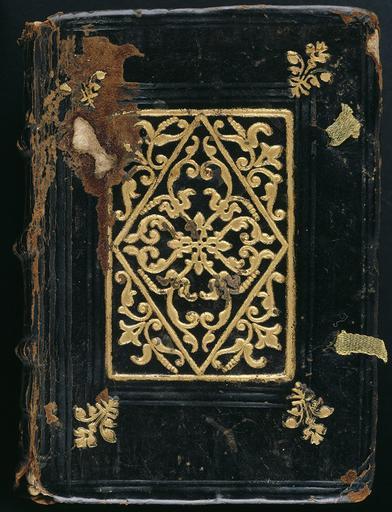MAKE A MEME
View Large Image

| View Original: | English_binding,_16th_century.jpg (783x1024) | |||
| Download: | Original | Medium | Small | Thumb |
| Courtesy of: | www.flickr.com | More Like This | ||
| Keywords: bookbinding historic antique book binding photo border Gold tooling (a decorative technique where a design is pressed into gold leaf that has been laid over the cover of a book) arrived in England in the early 16th century. The technique had been invented in the Arab world at least as early as the 13th century and was imported to Europe via the Italian trading ports in the mid 15th century. This London binding with cloth ties has been gold-tooled with a rare arabesque panel stamp. Panel stamps are large rectangular tools carrying pictorial or abstract designs, sometimes big enough to fill the cover of a small book in one stamping action. They were a timesaving measure and were particularly common on small books. The more labour-intensive alternative was to build up a pattern through repeated stamping using small individual stamps. Bequeathed to the Alexander Turnbull Library in 1973 by Sir Arthur Howard. Upper cover of Proverbes, ecclesiastes or preacher (Imprinted at London: by Richard Jugge the thyrd daye of Nouember, [1550?] Gold tooling (a decorative technique where a design is pressed into gold leaf that has been laid over the cover of a book) arrived in England in the early 16th century. The technique had been invented in the Arab world at least as early as the 13th century and was imported to Europe via the Italian trading ports in the mid 15th century. This London binding with cloth ties has been gold-tooled with a rare arabesque panel stamp. Panel stamps are large rectangular tools carrying pictorial or abstract designs, sometimes big enough to fill the cover of a small book in one stamping action. They were a timesaving measure and were particularly common on small books. The more labour-intensive alternative was to build up a pattern through repeated stamping using small individual stamps. Bequeathed to the Alexander Turnbull Library in 1973 by Sir Arthur Howard. Upper cover of Proverbes, ecclesiastes or preacher (Imprinted at London: by Richard Jugge the thyrd daye of Nouember, [1550?] | ||||